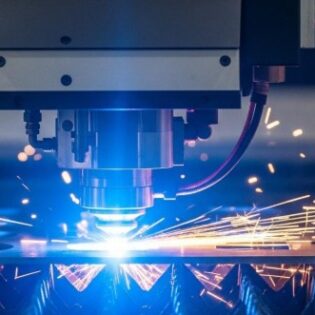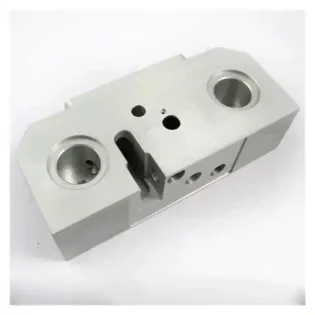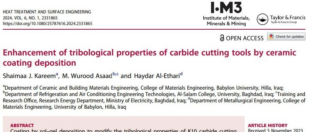
In high-temperature, high-wear industrial processing scenarios, the lifespan and performance of tungsten carbide (WC-Co) inserts directly determine production costs and efficiency. While traditional coating technologies (such as CVD/PVD) can enhance performance, their high-temperature processes often lead to a reduction in substrate hardness. How can we achieve low-temperature, high-efficiency coatings while maintaining high hardness, low friction, and thermal shock resistance? A recent study published in Heat Treatment and Surface Engineering (HTSE) provides an innovative solution!
Intro of the paper
Source
Kareem, S. J., Wurood Asaad, M., & Al-Ethari, H. ?Enhancement of tribological properties of carbide cutting inserts by ceramic coating deposition. Heat Treatment and Surface Engineering,(2024).?6(1).
https://doi.org/10.1080/25787616.2024.2331865
Abstract?from the paper
Coating by sol–gel deposition to modify the tribological properties of K10 carbide cutting tool was performed. The study examines the thermal and tribological characteristics of uncoated cutting inserts and the cutting inserts coated with TiO2/8YSZ and TiO2/15YSZ layers respectively. The TiO2/8YSZ and TiO2/15YSZ coatings had a hardness of 1151.6 and 1678.9 HV, respectively, and the TiO2/8YSZ and TiO2/15YSZ coated inserts had scratch hardness of 2.73 and 22.98 GPa respectively. Among the uncoated and coated tools, the TiO2/15YSZ coated inserts had the lowest coefficient of friction and rate of wear. The TiO2/8YSZ coated insert had a lower thermal conductivity when compared to TiO2/15YSZ coated insert and uncoated carbide cutting insert (10.3 vs. 14.1, and 41.8 W/m.K). The thermal expansion coefficients of the 8YSZ layers, 15YSZ layers, and carbide cutting insert were 3.66*10?6, 3.546*10?6?and 14*10?6?K?1, respectively. The reasons for the enhancement of the tribological properties of the carbide cutting inserts by the ceramic coatings are discussed.
Research Team
Materials Engineering Department, University of Babylon, Iraq
Technical Approach
Deposited TiO?/Yttria-Stabilized Zirconia (YSZ) multilayer ceramic coatings on K10 tungsten carbide (WC) inserts via sol-gel method, systematically analyzing the effects of 8% vs. 15% yttria content (8YSZ vs. 15YSZ) on performance.
Key Data Highlights (Partial data from Figure 1):
1.Hardness & Scratch Resistance
Microhardness:
15YSZ-coated insert: 1679 HV (vs. 866 HV for uncoated tool) → ~2× improvement
Scratch hardness: 15YSZ coating reached 22.98 GPa, indicating significantly enhanced interfacial adhesion.
2.Friction & Wear Performance
Coefficient of friction (CoF):
15YSZ coating: 0.17 (vs. 0.71 for uncoated tool) → 76% reduction! (See Figure 2)
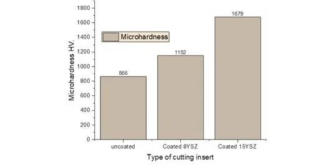
Figure 1. The micro hardness of uncoated tool and different coatings, and the images of indents produced on the surface of uncoated inserts and different coatings.
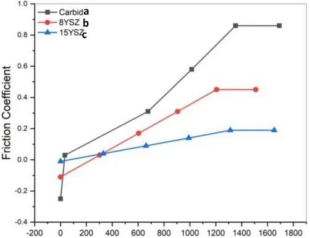
Figure 2. Coefficient of friction versus time of uncoated insert and the tools coated by TiO2/8YSZ and TiO2/15YSZ coatings respectively.

Figure 3. Wear rate of the uncoated and coated inserts.
3Wear Performance
15YSZ coating:
Wear rate: 0.24×10?3 g/m (85% reduction compared to uncoated tools, see Figure 3)
Thermal Performance Optimization
Thermal conductivity:
8YSZ coating: 10.3 W/m·K (effectively blocks cutting heat transfer)
Thermal expansion matching
YSZ coating (3.5-3.6×10?? K?1) vs. WC substrate (14×10?? K?1)
Minimal mismatch significantly reduces thermal stress-induced delamination risks
Technical Breakthroughs
1Low-Temperature Processing Advantage
2Sol-gel coating deposition achieved at 700°C (low-temperature)
3Avoids thermal damage to substrate caused by conventional high-temperature processes
4Achieves high purity and excellent uniformity (see Figure 4)
Content Optimization Mechanism
Grain refinement:
Increasing yttria content from 8% to 15% effectively inhibits grain growth and refines coating structure (XRD confirms stabilized cubic phase, see Figure 5)
Performance balance:
Higher yttria content (15YSZ) enhances hardness and wear resistance
Requires trade-off with slightly increased thermal conductivity compared to 8YSZ
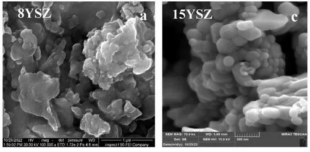
Figure 4. FESEM image of a multilayer coating (YSZ) on carbide tool: (a) 8YSZ 100000 Mag., (b) 8YSZ 25000 Mag.,
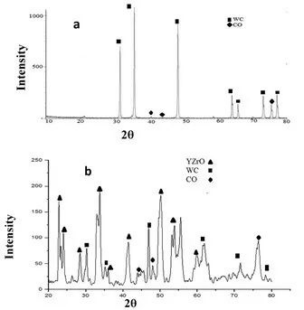
Figure 5. XRD Pattern of (a) carbide cutting insert, (b) 8YSZcoating, (c) 15 YZS coating.
Industrial Application Prospects
Extended Insert Lifespan:
Experimental results demonstrate over 50% longer tool life for coated inserts, making them ideal for high-wear applications like automotive manufacturing and mining drilling.
Cost Reduction:
An 85% reduction in wear rate translates to fewer инструмент replacements, significantly lowering machining costs.
Environmental Benefits:
The low friction coefficient reduces energy consumption, aligning with green manufacturing trends.
Вывод
This study not only provides an innovative solution for tungsten carbide tool coatings but also highlights the immense potential of sol-gel technology in high-temperature industrial components. Future optimization of yttria content and multilayer structure design could push performance boundaries even further!

